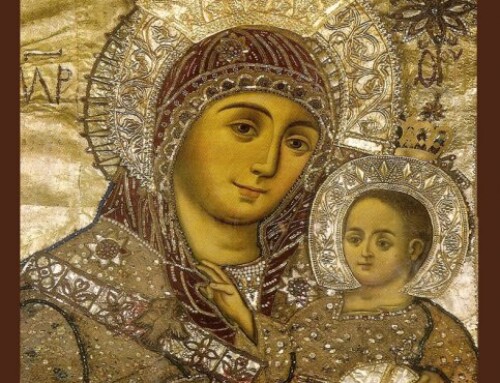Word Magazine April 1963 Page 8
TO BEND THE KNEE
By Fr. Michael Azkoul
Spring Valley, Illinois
I suspect that a discussion on posture during the Divine Liturgy might appear somewhat irrelevant to most people. But “posture” is not quite the subject of this essay, that is, posture as it is commonly understood. We are concerned here with what should be called “theological posture” or the theological significance of posture. I am speaking of a particular kind of posture related to a particular day — standing on Sunday.
When the first Christian temples (naos) were built, the architects neglected to put pews in the body of them. As an example, take the Church of St. Sophia in Constantinople. Even today one may enter an Orthodox church and find no pews. Why? It seems reasonable to assume that it was not for a lack of money. The purpose relates to posture — to standing up during the Liturgy, especially Sunday Liturgy. On Sunday it is unlawful “to bend the knee”, to kneel, at any time during the Liturgy.
Kneeling has always been understood as an act of repentance, sorrow and fear. Sunday, however, is “the Day of the Lord”, “the Day of the Resurrection”, that is the “Day” of conquest over “sin” and “death”. Sunday is the “Day” not “to bend the knee”, the “Day” in which our posture represents “victory” not humiliation. It is anactasis, or literally, “the standing up”. Standing up is the act of reverential boldness towards “Our Father” and the practicing symbol of our hope in the resurrection of all flesh.
Every Sunday is a “little Easter” and every Sunday Liturgy is a calling to remembrance of the Lord’s Resurrection and the bringing to mind of the hope of our own. To sit or kneel on Sunday would be understood by anyone who is liturgically knowledgeable, a denial of the Resurrection. Thus, the Fathers of the Church wrote this canon law:
“We have received it canonically from our God-bearing Fathers not to bend the knee on Sundays when we are honoring the Resurrection of Christ. Since this observance may not be clear to some of us, we are making it plain to the faithful. After the entrance of the clergy into the sanctuary on Saturday evening, let no one bend a knee until the evening of Sunday . . .“ (canon 40, 6th Ecumenical Council).
Sunday is “the Day of the Resurrection”, the “Day” in which our posture must always he erect. (The only exception is the Sunday of Pentecost, at the Kneeling Service).
St. Basil the Great makes it clear that Sunday is the memorial of the Resurrection, but also the figure of the age to come:
“We make our prayers standing on the first day of the week (Sunday) . . . For it is not only because we are risen with Christ and that we should seek the things which are above, that on the day of the Resurrection we recall the grace that has been given us by standing to pray: but also, I think, because this day is in some way the image of the future age . . .“ (De Spir. Sancto, 27)
As the “image” of “the age to come”, Sunday is called “the eighth Day”: it is the first and eighth day, the beginning and the end, thus, signifying a circle, which, as everyone knows, is the symbol of eternity. Sunday is symbolic of eternity. It is the “Day” after the Sabbath, the 7th Day. In eternity, there is no kneeling, no repentence, no sorrow, only joy, happiness. This is “the time” of the Resurrection, “the time” for “standing up” to which the Sunday Liturgy constantly points.
What may be said for sitting then? Pews have no place in the Orthodox Church. Pews came in as a result of the influence of the Western Renaissance and its idea that the Liturgy is a religious drama, a theatrical spectacle at which worshippers were spectators, an audience, watching the priest going through ritual motions for their entertainment. Since worshippers merely “attended” the Liturgy and did not participate in it, they were made comfortable; they sat. The Western “mass” became, therefore, something to arouse human feelings and offered aesthetic pleasure. Apparently, Renaissance man felt the best posture for the attainment of this end was sitting. The reality of the Liturgy as the recalling and hope of the Resurrection was lost.
The truth of the Resurrection, unfortunately, seems to be fading in the mind of many Orthodox. I suspect it is because we have failed to understand that “theological standing” was intended to bring home physically, vividly, practically, the very crown of the Christian religion—the Resurrection of Christ which is an anticipation of our own “in the age to come”.
BIBLE THOUGHTS
Let the words of my mouth, and the meditation of my heart, be acceptable in thy sight, 0 Lord, my strength, and my redeemer. (PSALM 19:14).
A truly saved man desires every thought and word to be in accordance with the desires of God.
Fight the good fight, lay hold on eternal life. (I TIM. 6:12).
Life eternal is a gift of God, given only to those who prepare themselves for it.


